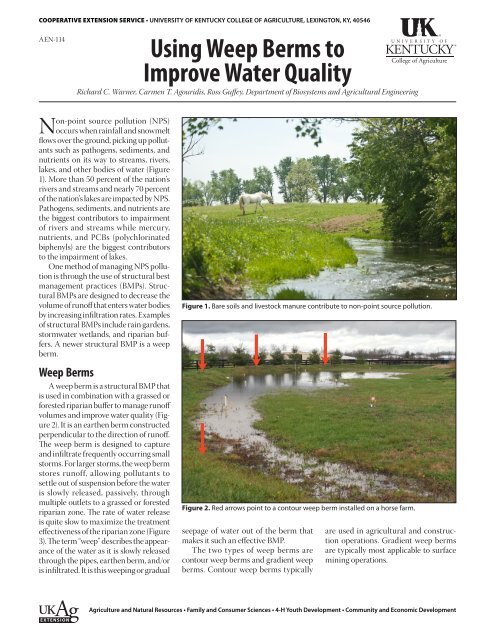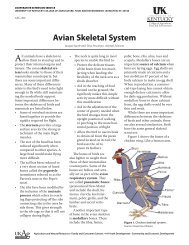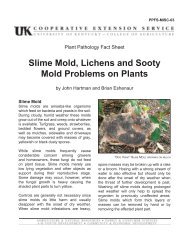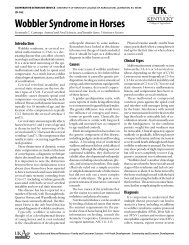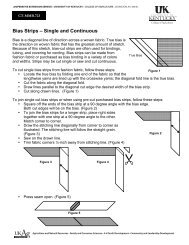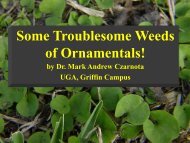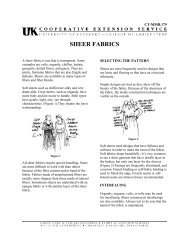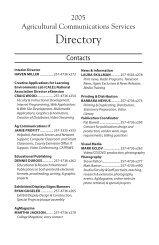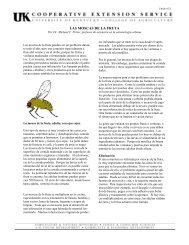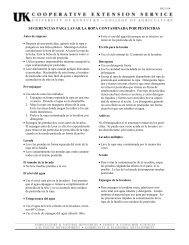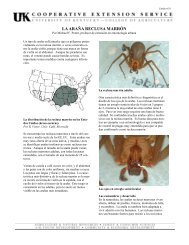AEN-114: Using Weep Berms to Improve Water Quality
AEN-114: Using Weep Berms to Improve Water Quality
AEN-114: Using Weep Berms to Improve Water Quality
You also want an ePaper? Increase the reach of your titles
YUMPU automatically turns print PDFs into web optimized ePapers that Google loves.
COOPERATIVE EXTENSION SERVICE • UNIVERSITY OF KENTUCKY COLLEGE OF AGRICULTURE, LEXINGTON, KY, 40546<br />
<strong>AEN</strong>-<strong>114</strong><br />
<strong>Using</strong> <strong>Weep</strong> <strong>Berms</strong> <strong>to</strong><br />
<strong>Improve</strong> <strong>Water</strong> <strong>Quality</strong><br />
Richard C. Warner, Carmen T. Agouridis, Ross Guffey, Department of Biosystems and Agricultural Engineering<br />
Non-point source pollution (NPS)<br />
occurs when rainfall and snowmelt<br />
flows over the ground, picking up pollutants<br />
such as pathogens, sediments, and<br />
nutrients on its way <strong>to</strong> streams, rivers,<br />
lakes, and other bodies of water (Figure<br />
1). More than 50 percent of the nation’s<br />
rivers and streams and nearly 70 percent<br />
of the nation’s lakes are impacted by NPS.<br />
Pathogens, sediments, and nutrients are<br />
the biggest contribu<strong>to</strong>rs <strong>to</strong> impairment<br />
of rivers and streams while mercury,<br />
nutrients, and PCBs (polychlorinated<br />
biphenyls) are the biggest contribu<strong>to</strong>rs<br />
<strong>to</strong> the impairment of lakes.<br />
One method of managing NPS pollution<br />
is through the use of structural best<br />
management practices (BMPs). Structural<br />
BMPs are designed <strong>to</strong> decrease the<br />
volume of runoff that enters water bodies<br />
by increasing infiltration rates. Examples<br />
of structural BMPs include rain gardens,<br />
s<strong>to</strong>rmwater wetlands, and riparian buffers.<br />
A newer structural BMP is a weep<br />
berm.<br />
<strong>Weep</strong> <strong>Berms</strong><br />
A weep berm is a structural BMP that<br />
is used in combination with a grassed or<br />
forested riparian buffer <strong>to</strong> manage runoff<br />
volumes and improve water quality (Figure<br />
2). It is an earthen berm constructed<br />
perpendicular <strong>to</strong> the direction of runoff.<br />
The weep berm is designed <strong>to</strong> capture<br />
and infiltrate frequently occurring small<br />
s<strong>to</strong>rms. For larger s<strong>to</strong>rms, the weep berm<br />
s<strong>to</strong>res runoff, allowing pollutants <strong>to</strong><br />
settle out of suspension before the water<br />
is slowly released, passively, through<br />
multiple outlets <strong>to</strong> a grassed or forested<br />
riparian zone. The rate of water release<br />
is quite slow <strong>to</strong> maximize the treatment<br />
effectiveness of the riparian zone (Figure<br />
3). The term “weep” describes the appearance<br />
of the water as it is slowly released<br />
through the pipes, earthen berm, and/or<br />
is infiltrated. It is this weeping or gradual<br />
Figure 1. Bare soils and lives<strong>to</strong>ck manure contribute <strong>to</strong> non-point source pollution.<br />
Figure 2. Red arrows point <strong>to</strong> a con<strong>to</strong>ur weep berm installed on a horse farm.<br />
seepage of water out of the berm that<br />
makes it such an effective BMP.<br />
The two types of weep berms are<br />
con<strong>to</strong>ur weep berms and gradient weep<br />
berms. Con<strong>to</strong>ur weep berms typically<br />
are used in agricultural and construction<br />
operations. Gradient weep berms<br />
are typically most applicable <strong>to</strong> surface<br />
mining operations.<br />
Agriculture and Natural Resources • Family and Consumer Sciences • 4-H Youth Development • Community and Economic Development<br />
EXTENSION
Con<strong>to</strong>ur weep berms are constructed<br />
along the con<strong>to</strong>ur which represents<br />
points of equal elevation. The ends of the<br />
con<strong>to</strong>ur weep berm turn up-gradient,<br />
perpendicular <strong>to</strong> the con<strong>to</strong>ur, <strong>to</strong> provide<br />
runoff s<strong>to</strong>rage. The shape of the con<strong>to</strong>ur<br />
weep berm resembles that of a horseshoe<br />
(Figure 4). If properly designed and<br />
constructed, con<strong>to</strong>ur weep berms blend<br />
in<strong>to</strong> the landscape (Figure 5). For long<br />
con<strong>to</strong>ur weep berms, earthen dikes can<br />
be installed at regular intervals <strong>to</strong> create<br />
runoff s<strong>to</strong>rage cells. The advantage being<br />
that if one cell fails, then the entire s<strong>to</strong>red<br />
volume of runoff is not discharged and<br />
the impact is minimized.<br />
Gradient weep berms are constructed<br />
in conjunction with a diversion ditch or<br />
a sediment ditch. Gradient weep berms<br />
incorporate the use of check dams along<br />
the length of the weep berm for the<br />
purpose of providing runoff detention<br />
(Figure 6). During larger s<strong>to</strong>rm events,<br />
check dams slow runoff flow along the<br />
weep berms, thus increasing infiltration<br />
and settling rates.<br />
Effectiveness of <strong>Weep</strong> <strong>Berms</strong><br />
<strong>Weep</strong> berms offer excellent results<br />
for small s<strong>to</strong>rms (one-year six-hour<br />
design s<strong>to</strong>rm) and good results for large<br />
s<strong>to</strong>rms (five-year 24-hour design s<strong>to</strong>rm).<br />
For design s<strong>to</strong>rms greater than the fiveyear<br />
24-hour event, weep berms provide<br />
structural stability. <strong>Weep</strong> berms are<br />
quite effective at reducing the volume<br />
of runoff entering streams and rivers<br />
with measured reduction rates typically<br />
between 60-90 percent. <strong>Weep</strong> berms<br />
are most effective in reducing sediment<br />
and sediment-associated constituents<br />
in runoff. When properly designed and<br />
maintained, reductions in sediment concentrations<br />
of about 90 percent are possible<br />
with a weep berm, with additional<br />
treatment occurring through the use<br />
of a riparian buffer. Reductions in fecal<br />
coliforms, nitrogen, and phosphorus also<br />
have been measured.<br />
Figure 3. Slow release of water from weep berm outlet <strong>to</strong> grassed riparian zone.<br />
Figure 4. Con<strong>to</strong>ur weep berm and riparian buffer treatment system.<br />
2
Figure 5. Cross-sectional view of a con<strong>to</strong>ur weep berm.<br />
Advantages of <strong>Weep</strong> Berm<br />
<strong>Weep</strong> berms offer a number of advantages.<br />
First, weep berms provide linear<br />
runoff control, meaning they require less<br />
land for construction. Often times weep<br />
berms are constructed along the perimeter<br />
of a land disturbance. <strong>Weep</strong> berms<br />
promote infiltration and sedimentation.<br />
With gradient weep berms, the spaces between<br />
the check dams allow for sediment<br />
s<strong>to</strong>rage, as do the spaces between the<br />
earthen dikes for con<strong>to</strong>ur weep berms.<br />
In many instances, weep berms allow<br />
for the down-sizing or even elimination<br />
of sediment ponds. Runoff from small<br />
s<strong>to</strong>rm events is completely captured<br />
and infiltrated while a sizeable portion<br />
of runoff from large events is s<strong>to</strong>red and<br />
infiltrated. Additionally, weep berms are<br />
simple and cost effective <strong>to</strong> construct. For<br />
small areas (fewer than 10 acres), a skid<br />
steer, backhoe, or track hoe can be used.<br />
Designing a <strong>Weep</strong> Berm<br />
Siting Considerations<br />
<strong>Weep</strong> berms are placed down-gradient<br />
of disturbed areas. Linear developments<br />
such as haul roads, pipe lines, and<br />
transmission lines are ideal. Other appropriate<br />
locations include those downgradient<br />
of <strong>to</strong>psoil/spoil s<strong>to</strong>ckpile areas,<br />
cut or fill slopes, manure s<strong>to</strong>rage and/or<br />
composting facilities, high lives<strong>to</strong>ck use<br />
areas, fields receiving manure applications<br />
or injections, and dairy or hog waste<br />
lagoons.<br />
For con<strong>to</strong>ur weep berms, the slope of<br />
the land up-gradient of the weep berm<br />
should not exceed 25 percent. With<br />
gradient weep berms, the slope of the<br />
diversion channel, which is parallel <strong>to</strong><br />
the weep berm, should not exceed 10<br />
percent. No restrictions are on the slope<br />
of the land up-gradient of gradient weep<br />
berms.<br />
Consideration should also be given <strong>to</strong><br />
the type of soil on which the weep berm<br />
is constructed. Sandy soils have high<br />
infiltration rates while clay soils have<br />
low infiltration rates (Table 1). The type<br />
of soil present will affect the size of the<br />
weep berm and dewatering rates. Larger<br />
weep berms will be needed for soils with<br />
low infiltration rates.<br />
In addition <strong>to</strong> soil type, consideration<br />
should be given <strong>to</strong> the effect of pollutant<br />
loads on infiltration rates. Runoff high<br />
in organic matter, such as with runoff<br />
from areas with manure, can result in<br />
the formation of a thick biofilm or mat<br />
immediately up-gradient of the weep<br />
berm. Over time, infiltration rates will<br />
decrease. To prevent this decrease, the<br />
mat should be removed and the underlying<br />
soil loosened.<br />
When siting the weep berm, be sure<br />
<strong>to</strong> consider accessibility for cleaning<br />
out sediments deposited behind the<br />
Figure 6. Gradient weep berm installed at a school construction site in Georgia.<br />
3
Table 1. Typical Infiltration Rates for Soil Types.<br />
Infiltration<br />
Rate<br />
HSG 1 Soil Texture<br />
(in./hr)<br />
A Sand, loamy sand, >0.30<br />
sandy loam<br />
B Silt loam, loam 0.15-0.30<br />
C Sandy clay loam 0.05-0.15<br />
D Clay loam, silty clay
The weep berm height is set such that<br />
the runoff volume from the five-year<br />
24-hour s<strong>to</strong>rm event is contained. For<br />
instances when the weep berm is used <strong>to</strong><br />
control sediment-laden runoff, the weep<br />
berm height should also accommodate<br />
the necessary sediment s<strong>to</strong>rage capacity.<br />
A trade-off exists between sediment<br />
s<strong>to</strong>rage capacity, meaning a larger weep<br />
berm, and frequency of clean out. The<br />
inverts of the outlets are set such that<br />
the one-year six-hour s<strong>to</strong>rm is contained<br />
in addition <strong>to</strong> any sediment s<strong>to</strong>rage<br />
capacity requirements. Sufficient equipment<br />
access <strong>to</strong> the weep berm should<br />
be provided <strong>to</strong> allow for the removal of<br />
deposited sediments.<br />
Gradient <strong>Weep</strong> <strong>Berms</strong><br />
The main design components of<br />
a gradient weep berm involve a trapezoidal<br />
channel, check dams within<br />
the trapezoidal channel, and outlets<br />
through the down-gradient side slope of<br />
the trapezoidal channel (Figure 6). The<br />
designer must determine the bot<strong>to</strong>m<br />
width, side-slopes, and overall slope of<br />
the trapezoidal channel.<br />
For the check dams, the <strong>to</strong>p or crest<br />
determines amount of runoff that is<br />
s<strong>to</strong>red. The heights of the check dams are<br />
set such that the runoff from the five-year<br />
24-hour s<strong>to</strong>rm is contained while considering<br />
sediment s<strong>to</strong>rage requirements.<br />
The spacing of check dams affects the<br />
volume of runoff that is s<strong>to</strong>red. Typically<br />
check dams are spaced such that<br />
the crest of the adjacent down-gradient<br />
check dam equates <strong>to</strong> 25-50 percent of<br />
the height of the immediate up-gradient<br />
check dam. As with the con<strong>to</strong>ur weep<br />
berm, the inverts of the outlets are set<br />
such that the one-year six-hour s<strong>to</strong>rm is<br />
contained in addition <strong>to</strong> any sediment<br />
s<strong>to</strong>rage capacity requirements.<br />
Outlets<br />
Though a number of outlet types<br />
have been used in the past, such as fixed<br />
siphons and perforated risers, only<br />
straight pipes and rock lenses are recommended<br />
at this time. While the invert of<br />
the outlet is set such that the one-year<br />
six-hour s<strong>to</strong>rm is contained, over any<br />
sediment capacity requirements, the<br />
designer must determine the type, size,<br />
shape, and spacing of the outlets. These<br />
Figure 7. Outlet options for weep berms include pipes and rock lenses.<br />
characteristics will control the rate of<br />
water discharge from the weep berm.<br />
For straight pipe outlets, schedule 40<br />
PVC is often used. The designer must<br />
determine the pipe diameter and the<br />
pipe slope. For rock lenses, the designer<br />
must determine the width and height<br />
of the outlet along with the size of rock<br />
used. Figure 7 shows commonly used<br />
outlet configurations.<br />
Riparian Buffer<br />
A grassed or forested riparian buffer is<br />
an important part of the weep berm design.<br />
The required width of the riparian<br />
buffer is a function of slope, vegetation<br />
type, and soil types. A riparian buffer<br />
with sufficient width can infiltrate all<br />
runoff, from a five-year 24-hour s<strong>to</strong>rm,<br />
discharged from the weep berm. Such<br />
high efficiencies are achieved when<br />
runoff is slowly discharged. If space constraints<br />
limit the width of the riparian<br />
buffer, then smaller outlets will release<br />
water more slowly. However, the tradeoff<br />
is that the weep berm will be bigger<br />
<strong>to</strong> contain the five-year 24-hour s<strong>to</strong>rm<br />
event.<br />
Constructing a <strong>Weep</strong> Berm<br />
Typical on-site construction or farm<br />
equipment such as a skid steer, backhoe,<br />
or track hoe are generally used <strong>to</strong><br />
construct weep berms. The first step is<br />
<strong>to</strong> remove all vegetation from the footprint<br />
of the weep berm, taking care <strong>to</strong><br />
minimize damage <strong>to</strong> any up-gradient or<br />
down-gradient vegetation. As the rate of<br />
infiltration is important <strong>to</strong> the efficiency<br />
of the weep berm, it is important <strong>to</strong> minimize<br />
soil compaction both up-gradient<br />
and down-gradient of the weep berm.<br />
If necessary, these soils may require<br />
loosening following construction of the<br />
weep berm.<br />
It is important <strong>to</strong> compact the weep<br />
berm such that it is structurally stable<br />
but not <strong>to</strong> the point that runoff cannot<br />
seep through the earthen berm. Soils<br />
most suitable for constructing weep<br />
berms are those with greater than 10<br />
percent clay content, greater than 20<br />
percent silt and clay content, and the<br />
remaining percentage sand and gravel<br />
(e.g. gravelly clays, sandy clays, silty clays,<br />
poorly graded sand-clay, or gravel-sandclay<br />
mixtures).<br />
5
It is recommended that the weep berm<br />
be constructed in 6- <strong>to</strong> 9-inch lifts using<br />
the wheels or tracks of the equipment<br />
<strong>to</strong> compact the berm. It is important<br />
<strong>to</strong> survey the crest of the weep berm <strong>to</strong><br />
ensure it is level within the allowable<br />
design <strong>to</strong>lerance (±0.25 feet is recommended).<br />
Alternatively, compaction with<br />
the bucket of a backhoe or track hoe is<br />
often adequate.<br />
Placement of the outlets is done<br />
either during berm construction or immediately<br />
following berm construction.<br />
If the outlets are placed during berm<br />
construction, care must be taken not <strong>to</strong><br />
crush the outlets when compacting soil,<br />
particularly when using PVC pipes. In<br />
such instances, larger soil lifts are recommended.<br />
For outlet placement post-berm<br />
construction, an excava<strong>to</strong>r is needed<br />
<strong>to</strong> dig trenches for outlet placement.<br />
Depending on the outlet configuration,<br />
backfilling and careful compaction using<br />
the bucket on an excava<strong>to</strong>r or similar<br />
piece of equipment may be required.<br />
Alternatively, a steel pipe with a conical<br />
end can be used <strong>to</strong> develop a hole for<br />
subsequently inserting the PVC pipes.<br />
Lastly, erosion control measures are<br />
needed. Seed the weep berm and install<br />
an erosion-control blanket. Use products<br />
that are free of plastic netting. Plastic netting<br />
can trap and kill wildlife and is easily<br />
entangled in mowers. It is not a requirement<br />
<strong>to</strong> mow the weep berm, however<br />
some landowners prefer a mowed appearance.<br />
If mowing is desired, be sure<br />
<strong>to</strong> consider the steepness of the berm<br />
when selecting the method of mowing.<br />
Riding lawn mowers typically should not<br />
be operated on slopes steeper than 15<br />
percent. Be sure <strong>to</strong> check all appropriate<br />
owner’s manuals before operating mowing<br />
equipment.<br />
Maintenance Requirements<br />
<strong>Weep</strong> berms require little maintenance<br />
outside of periodic sediment removal<br />
and occasional mowing, if desired<br />
by the landowner. Clogging of outlets is<br />
rare as the outlets are above the sediment<br />
s<strong>to</strong>rage layer. A long piece of rebar is useful<br />
for unclogging a pipe. For rock lenses,<br />
any reduction in efficiency is most likely<br />
<strong>to</strong> occur at the lower portion of the lens<br />
closest <strong>to</strong> the sediment s<strong>to</strong>rage layer.<br />
6
Con<strong>to</strong>ur <strong>Weep</strong> Berm Design Example<br />
Alexa wants <strong>to</strong> design a con<strong>to</strong>ur weep berm <strong>to</strong> collect<br />
sediment-laden runoff from a 4 acre newly graded construction<br />
site in Fayette County, Kentucky. The land slope up-gradient of<br />
the planned location of the weep berm is 2 percent. The linear<br />
extent of disturbance is 500 feet. Soils at the project site are<br />
Bluegrass-Maury silt loam, which places them in HSG B. For<br />
sediment s<strong>to</strong>rage requirements, she needs 67 cubic yards per<br />
acre of disturbed land.<br />
<strong>Using</strong> the Rainfall Frequency Values for Kentucky, Engineering<br />
Memorandum No. 2, Alexa determines that the one-year<br />
six-hour rainfall depth is 1.9 inches and the five-year 24-hour<br />
rainfall depth is 3.8 inches for Fayette County.<br />
To design the con<strong>to</strong>ur weep berm, Alexa must complete the<br />
following steps:<br />
1. Develop a berm height <strong>to</strong> s<strong>to</strong>rage volume relationship for a<br />
2 percent slope and a 500-foot berm length.<br />
2. Determine the sediment s<strong>to</strong>rage requirements for the weep<br />
berm.<br />
3. Determine the runoff volume associated with the one-year<br />
six-hour design s<strong>to</strong>rm (Equations 1 and 2).<br />
4. Determine the invert elevation of the outlet by adding the<br />
sediment s<strong>to</strong>rage requirements (Step 2) <strong>to</strong> the runoff volume<br />
of the one-year six-hour s<strong>to</strong>rm event (Step 3).<br />
5. Determine the runoff volume associated with the five-year<br />
24-hour design s<strong>to</strong>rm (Equations 1 and 2).<br />
6. Determine the crest elevation of the weep berm by adding<br />
the sediment s<strong>to</strong>rage requirements (Step 2) <strong>to</strong> the runoff<br />
volume of the five-year 24-hour s<strong>to</strong>rm event (Step 5).<br />
7. Select an outlet type and size.<br />
Step 1: Stage-S<strong>to</strong>rage Relationship<br />
Assume the deposited sediment will<br />
form a triangular wedge, the watershed<br />
slope is constant, and the interior weep<br />
berm slope is 1.5:1 (height <strong>to</strong> volume).<br />
Calculate the volume of sediment that<br />
could be s<strong>to</strong>red behind a 500 ft long weep<br />
berm of varying heights. Table 3 contains<br />
the weep berm height <strong>to</strong> s<strong>to</strong>rage relationship<br />
for a 500 ft length of weep berm<br />
with the aforementioned characteristics.<br />
Recall 1 ac=43,560 ft 2 .<br />
Step 2: Sediment S<strong>to</strong>rage Requirements<br />
The given sediment s<strong>to</strong>rage requirement<br />
is 67 yd 3 per acre of disturbed<br />
land. For 4 acres, 268 yd 3 or 0.166 ac-ft is<br />
required. Recall 1 yd 3 =27ft 3 . Use Table 3<br />
<strong>to</strong> determine the associated weep berm<br />
height (0.71 ft) for a sediment s<strong>to</strong>rage<br />
volume of 0.166 ac-ft.<br />
Table 3. <strong>Weep</strong> Berm Height-<strong>to</strong>-S<strong>to</strong>rage-<br />
Volume Relationship (2% <strong>Water</strong>shed Slope;<br />
500-ft <strong>Weep</strong> Berm Length).<br />
<strong>Weep</strong> Berm Height<br />
(ft)<br />
S<strong>to</strong>rage Volume<br />
(ac-ft)<br />
0.5 0.0739<br />
1.0 0.2956<br />
1.5 0.6650<br />
2.0 1.1823<br />
2.5 1.8473<br />
3.0 2.6601<br />
3.5 3.6207<br />
4.0 4.7291<br />
Step 3: Runoff Volume for One-year Sixhour<br />
Design S<strong>to</strong>rm<br />
The CN for a newly graded Bluegrass-<br />
Maury silt loam (HSG B) is 86 (Table 2).<br />
For a 1.9 inch rainfall depth over 4 acres,<br />
the associated runoff volume is 0.258 acft.<br />
Step 4: Outlet Invert Elevation<br />
Add the sediment s<strong>to</strong>rage requirement<br />
(0.166 ac-ft) and the runoff volume<br />
from the one-year six-hour design s<strong>to</strong>rm<br />
(0.258 ac-ft). Use Table 3 <strong>to</strong> determine<br />
the elevation of the outlet invert (1.17 ft).<br />
This elevation corresponds <strong>to</strong> the point<br />
along the weep berm where the con<strong>to</strong>ur<br />
elevation is lowest.<br />
Step 5: Runoff Volume for Five-year 24-<br />
hour Design S<strong>to</strong>rm<br />
For a 3.8 in. rainfall depth over 4 acres<br />
and a CN of 86, the associated runoff<br />
volume is 0.789 ac-ft.<br />
Step 6: Crest Elevation<br />
Add the sediment s<strong>to</strong>rage requirement<br />
(0.166 ac-ft) and the runoff volume<br />
from the five-year 24-hour design s<strong>to</strong>rm<br />
(0.789 ac-ft). Use Table 3 <strong>to</strong> determine the<br />
elevation of the crest of the weep berm<br />
(1.82 ft). This elevation corresponds <strong>to</strong><br />
the point along the weep berm where the<br />
con<strong>to</strong>ur elevation is lowest.<br />
Step 7: Outlet Type and Size<br />
Select both the type and size of the<br />
outlets so that s<strong>to</strong>red runoff is slowly<br />
released, preferably <strong>to</strong> a down-gradient<br />
riparian area. Discharge should be relatively<br />
uniform across the weep berm. For<br />
this example, 24 equally spaced 1-in. PVC<br />
pipes are used.<br />
7
Useful Information<br />
Technical Paper No. 40 (TP-40). Rainfall<br />
Frequency Atlas of the United States<br />
for Durations from 30 Minutes <strong>to</strong> 24<br />
Hours and Return Periods from 1 <strong>to</strong><br />
100 Years. Available at: http://www.<br />
nws.noaa.gov/oh/hdsc/PF_documents/TechnicalPaper_No40.pdf.<br />
Rainfall Frequency Values for Kentucky,<br />
Engineering Memorandum No. 2.<br />
Available at: http://water.ky.gov/<br />
permitting/Documents/WRRainfall_Frequency.pdf.<br />
SEDCADTM 4 Design Manual and<br />
User’s Guide.<br />
Manual for Erosion and Sediment Control<br />
in Georgia, 5th ed. Available at:<br />
http://www.georgiaplanning.com/<br />
water<strong>to</strong>olkit/Documents/<strong>Water</strong>ProtectionIssues/Chapter6Sec1.pdf.<br />
References<br />
Agouridis, C.T., S.J. Wightman, J.A.<br />
Villines, and J.D. Luck. 2011. <strong>AEN</strong>-<br />
106 Reducing S<strong>to</strong>rmwater Pollution.<br />
University of Kentucky Cooperative<br />
Extension Service. Available at:<br />
http://www.ca.uky.edu/agc/pubs/aen/<br />
aen106/aen106.pdf.<br />
Barnett, J.R., R.C. Warner, C.T. Agouridis,<br />
and D.R. Edwards. 2010. Ability of a<br />
<strong>Weep</strong> Berm <strong>to</strong> Enhance Grass Filter<br />
Performance in a Simulated Grazed<br />
System: Preliminary Results. Natural<br />
and Environmental Sciences 1: 12-20.<br />
Iowa S<strong>to</strong>rmwater Management Manual.<br />
2008. 2C-5 NRCS TR-5 Methodology.<br />
Iowa State University. Available at:<br />
http://www.intrans.iastate.edu/pubs/<br />
s<strong>to</strong>rmwater/index.cfm.<br />
U.S. Department of Agriculture, Natural<br />
Resource Conservation Service. 2004.<br />
National Engineering Handbook, Part<br />
630 Hydrology. Available at: ftp://<br />
ftp.wcc.nrcs.usda.gov/wntsc/H&H/<br />
NEHhydrology/ch9.pdf.<br />
U.S. Environmental Protection Agency<br />
[USEPA]. 1996. Nonpoint Source<br />
Pollution: The Nations’ Largest <strong>Water</strong><br />
<strong>Quality</strong> Problem. Pointer No. 1,<br />
EPA841-F-96-004A. Available at:<br />
http://water.epa.gov/polwaste/nps/<br />
outreach/point1.cfm.<br />
U.S. Environmental Protection Agency<br />
[USEPA]. 2012. <strong>Water</strong> <strong>Quality</strong> Assessment<br />
and Total Maximum Daily<br />
Loads Information, National Summary<br />
of State Information. Available<br />
at: http://iaspub.epa.gov/waters10/<br />
attains_nation_cy.control#STREAM/<br />
CREEK/RIVER<br />
Warner, R.C., T.W. Sturm, and S. Torrealba.<br />
2007. Seep Berm Design Manual.<br />
Georgia EPD and U.S. Environmental<br />
Protection Agency, Atlanta, GA.<br />
Pho<strong>to</strong>graphs by Matt Bar<strong>to</strong>n, Agricultural Communications;<br />
and Ross Guffey, Tracy Atkinson, and Richard Warner, Biosystems and<br />
Agricultural Engineering.<br />
Illustrations by Corey Wilson, Landscape Architecture.<br />
Funding for this publication was provided in part by the Lexing<strong>to</strong>n-Fayette<br />
Urban County Government (LFUCG) S<strong>to</strong>rmwater <strong>Quality</strong> Projects Incentive<br />
Grant Program and the United States Department of Agriculture Natural<br />
Resources Conservation Service (USDA-NRCS).<br />
Educational programs of Kentucky Cooperative Extension serve all people regardless of race, color, age, sex, religion, disability, or national origin. Issued in furtherance of Cooperative<br />
Extension work, Acts of May 8 and June 30, 1914, in cooperation with the U.S. Department of Agriculture, M. Scott Smith, Direc<strong>to</strong>r of Cooperative Extension Programs, University<br />
of Kentucky College of Agriculture, Lexing<strong>to</strong>n, and Kentucky State University, Frankfort. Copyright © 2011 for materials developed by University of Kentucky Cooperative<br />
Extension. This publication may be reproduced in portions or its entirety for educational or nonprofit purposes only. Permitted users shall give credit <strong>to</strong> the author(s) and include<br />
this copyright notice. Publications are also available on the World Wide Web at www.ca.uky.edu.<br />
Issued 11-2012


